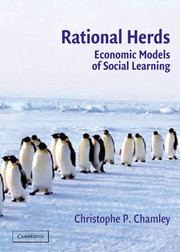Book contents
- Frontmatter
- Contents
- Preface
- 1 Introduction
- PART ONE Social Learning
- 2 Bayesian Tools
- 3 Social Learning with a Common Memory
- 4 Cascades and Herds
- 5 Limited Memories
- 6 Delays
- 7 More Delays
- 8 Outcomes
- 9 Networks and Diffusion
- 10 Words
- PART TWO Coordination
- PART THREE Financial Herding
- References
- Author Index
- Subject Index
2 - Bayesian Tools
Published online by Cambridge University Press: 12 January 2010
- Frontmatter
- Contents
- Preface
- 1 Introduction
- PART ONE Social Learning
- 2 Bayesian Tools
- 3 Social Learning with a Common Memory
- 4 Cascades and Herds
- 5 Limited Memories
- 6 Delays
- 7 More Delays
- 8 Outcomes
- 9 Networks and Diffusion
- 10 Words
- PART TWO Coordination
- PART THREE Financial Herding
- References
- Author Index
- Subject Index
Summary
Practice makes perfect.
The Bayesian framework is introduced. The main tools for the models in this book are the binary modelwith two states of nature and the Gaussian model with a normal distribution of information. The correspondence between private information and private beliefs is discussed. Because rational beliefs will often be martingales, the martingale convergence theorem will be used repeatedly. Its mechanism is described intuitively.
A Witness with No Historical Knowledge
In a town there are cabs of two colors, yellow and red. Ninety percent of the cabs are yellow. One night, a cab hits a pedestrian and leaves the scene without stopping. The skills and the ethics of the driver do not depend on the color of the cab. An out-of-town witness claims that the cab was red. The witness does not know the proportion of yellow and red cabs in the town and makes a report on the sole basis of what he thinks he has seen. Because the accident occurred at night, the witness is not completely reliable, but it has been assessed that under similar circumstances, his probability of making a correct statement is four out of five (whether the true color of the cab is yellow or red). How should one use the information of the witness? Because of the uncertainty, we should formulate our conclusion in terms of probabilities. Is it more likely then that a red cab was involved in the accident? Although the witness reports red and is correct 80 percent of the time, the answer is no.
Information
- Type
- Chapter
- Information
- Rational HerdsEconomic Models of Social Learning, pp. 19 - 41Publisher: Cambridge University PressPrint publication year: 2003
